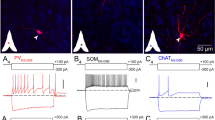Abstract
An investigation of the effect of opioid peptides (leucine-enkephalin and methionine-enkephalin) on the plastic properties of the system of monosynaptically connected LPa7-LPa3 and RPa3, and LPa8-LPa3 and RPa3, neurons in the brain of the edible snail was carried out. It was demonstrated that all three elements in the system under investigation (the presynaptic neuron, the postsynaptic neuron, and the synapse) display the same type of plasticity, i.e., habituation to rhythmic stimulation. The enkephalins exert a modulating effect on the plastic properties of the presynaptic neuron and synapse: they slow down the habituation of the presynaptic neuron in response to intracellular stimulation and the development of habituation at a level of the synapse as well. However, the changes in the character of the postsynaptic response in the presence of enkephalins are not the direct consequence of their influence on the plastic properties of the presynaptic neuron. In addition, the enkephalins decrease the efficiency of synoptic transmission in this system: they decrease the duration of the EPSP in the postsynaptic neuron.
Similar content being viewed by others
Literature cited
G. G. Arakelov, “The interrelationships of the synaptic and pacemaker potentials in the giant neurons of the edible snail,”Zh. Évol. Biokhim. i Fiziol., No. 6, 78–84 (1971).
G. G. Arakelov, I. V. Marakueva, and T. A. Palikhova, “The monosynaptic connection: identified synapses in the CNS of the edible snail,”Zh. Vyssh. Nerv. Deyat.,39, No. 4, 737–745 (1989).
T. N. Grechenko and L. K. Khludova, “Mechanisms of habituation of the command neuron,” in:The Comparative Physiology of Higher Nervous Activity [in Russian], Nauka, Moscow (1988).
T. L. D'yakonova, “Two types of neurons which differ with respect to the plastic properties: a study of ionic mechanisms,”Zh. Vyssh. Nerv. Deyat.,35, No. 3, 552 (1985).
T. L. D'yakonova, “The regulation of the plastic properties of the electroexcitable membrane of the neuron by serotonin,”Zh. Vyssh. Nerv. Deyat.,35, No. 4, 753–758 (1985).
T. L. D'yakonova, “The effects of the enkephalins in the somatic membrane of identified neurons of the edible snail,” in:Simple Nervous Systems. Materials of the II All-Union Conference [in Russian], Nauka, Leningrad (1988), pp. 93–96.
R. I. Kruglikov, G. I. Chipens, V. M. Getsova et al., “Some mechanisms of the action of enkephalins on the processes of learning and memory,”Biol. Nauki,12, No. 4,45–60 (1984).
D. B. Logunov and P. M. Balaban, “The monosynaptic connection between identified neurons of the edible snail,”Dokl. Akad. Nauk SSSR,240, No. 1, 237–240 (1978).
D. B. Logunov, “The relationship of fast and slow elementary synaptic potentials in the command neurons of the edible snail,”Zh. Vyssh. Nerv. Deyat.,33, No. 2, 355–362 (1983).
G. E. Samonina and E. V. Mandriko, “Peripheral cholinolytic action—one of the effects of sydnophen,”Byull. Éksp. Biol. Med.,106, No. 4, 449–451 (1989).
E. N. Sokolov and A. L. Yarmizina, “The habituation of the giant neuron of the snail to repeated intracellular stimulations,” in:Neuronal Mechanisms of the Orienting Reflex [in Russian], Izd-vo MGU, Moscow (1970), pp. 111–117.
A. G. Ter-Markarian, T. A. Palikhova, and E. N. Sokolov, “The action of atropine and d-tubocurarine on the monosynaptic connection between identified neurons in the CNS of the edible snail,”Zh. Vyssh. Nerv. Deyat.,40, No. 1, 183 (1990).
I. Izquierdo, R. D. Dias, D. O. Souzo et al., “The role of opioid peptides in memory and learning,”Behav. Brain. Res.,1, No. 6, 451–456(1980).
R. M. Kreem, R. S. Zukin, and G. B. Slefano, “Demonstration of Iwo classes of opiate binding sites in the nervous tissue of the marine molluscMytilus equlis [sic]. Positive homotropic cooperalivity of lower affinity binding sites,”J. Biol. Chem.,255, No. 19, 9218–9224 (1980).
M. K. Leung and G. B. Stefano, “Isolation and identification of enkephalin in pedal ganglia ofMytilus equlis [sic] (Mollusca),”Proc. Nat. Acad. Sci. USA,81, No. 3, 955–958 (1984).
K. Lukowiak, J. A. Thornhill, and J. Edstrom, “Methionine-enkephalin increases CNS suppressive control exerted over gill reflex behavior and associated neural activity inAplysia California,” in:Regulatory Peptides,3, Nos. 3–4, 303–312(1982).
Author information
Authors and Affiliations
Additional information
Translated from Zhurnal Vysshei Nervnoi Deyatel'nosti imeni I. P. Pavlova, Vol. 41, No. 4, pp. 788–795, July–August, 1991.
Rights and permissions
About this article
Cite this article
D'yakonova, T.L., Arakelov, G.G. The monosynaptic connection: Modulating influence of opioid peptides on the plasticity of presynaptic neurons and identified synapses. Neurosci Behav Physiol 22, 386–392 (1992). https://doi.org/10.1007/BF01186630
Received:
Revised:
Issue Date:
DOI: https://doi.org/10.1007/BF01186630




